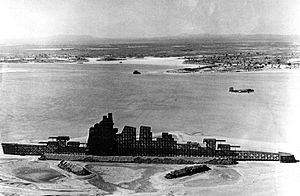Muroc Maru facts for kids
Quick facts for kids AAF Temporary Building (Target) T-799"Muroc Maru" |
|
|---|---|
| Part of Muroc Army Air Base | |
| Rogers Dry Lake, California | |

The "Muroc Maru" overflown by a B-25 Mitchell
|
|
| Coordinates | 34°50′40″N 117°53′24″W / 34.84444°N 117.89000°W |
| Type | Target facility |
| Site information | |
| Open to the public |
No |
| Condition | Razed |
| Site history | |
| Built | 1943 |
| Built by | U.S. Army Air Forces |
| In use | 1943–1950 |
| Demolished | 1950 |
| Garrison information | |
| Garrison | Edwards Air Force Base, California |
The Muroc Maru was a special training target built during World War II in California. Its official name was AAF Temporary Building (Target) T-799. It looked like a Japanese warship called a Takao-class heavy cruiser. This fake ship was used to help bomber pilots and bombardiers (people who drop bombs from planes) practice how to attack enemy ships. The Muroc Maru stayed on Rogers Dry Lake until 1950, when it was taken apart.
Building the Fake Warship
AAF Temporary Building (Target) T-799 was built in 1943. It was placed on the southern part of Rogers Dry Lake in California. The main goal was to train pilots, navigators, and bombardiers from the United States Army Air Forces. They learned how to bomb, strafe (shoot at targets from a low-flying aircraft), and identify different warships. They also practiced a special technique called skip bombing.
The dry lakebed was chosen for this training structure for a good reason. Bright sand dunes were shaped around the 'ship' to look like waves or a wake. This made the fake ship seem like it was actually floating at sea.
The structure was made to look exactly like a Takao-class heavy cruiser from the Imperial Japanese Navy. It was built using four-by-four lumber and chicken wire. Tar paper was used to cover the "hull" (the body of the ship) to make it look solid and complete. Building this unique training target cost $35,819.18 in 1943.
How the Muroc Maru Was Used

Once the fake ship was finished, pilots from the nearby Muroc Army Air Field started training there. This base is now known as Edwards Air Force Base. The pilots gave the training ship the nickname Muroc Maru. "Muroc" came from the base's name, and "Maru" is a common ending for Japanese ship names.
The Muroc Maru was used for training until 1950. At that time, it was decided that the structure was a danger to planes flying in the area. After making sure there were no unexploded bombs or other dangers nearby, the Muroc Maru was taken apart.

